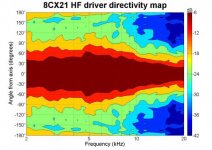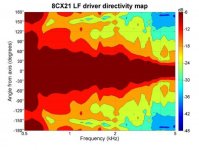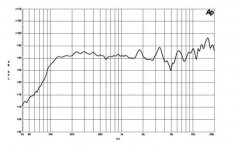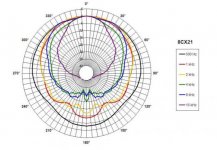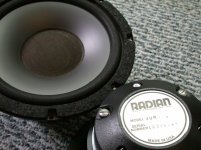I don't agree.Ok. I wasn't giving a general opinion on compression tweeters. Just saying that in a coax, you don't have enough space for a high-end one.
These days, I'm starting thinking about a new project : "Multi-role" ultra-compact active speakers, mostly to be used as PA floor monitors, but with a real hifi quality to them.
Speaking from experience, the two goals are mutually exclusive, sorry. A decent stage monitor needs to be hard, bright and cutting, with narrow-ish directivity to avoid feedback problems, with, (apart from drum fills) no need to go below about 100Hz. This is to cut across ambient noise, whether it be a manic drummer, a noisy pub crowd, or even just the low level chatter in a restaurant type gig. Not really what you want in a home hi-fi speaker. You could possibly do something with switchable crossovers, but the complexity may well cost more than the project is worth.
For example, for a wedge, I'd be looking at a first order HPF at about 300Hz to reduce muddiness below the voice range, a nice peak at about 1K to increase definition, and rolling off gently above about 8K to reduce feedback problems. Not nice to listen to under domestic conditions, but exactly what you need on stage.
Pinkmouse,
Of course the goals are mutually exclusive. Therefore, I'm looking at finding the best compromise (BTW, I can store different settings of the active filter for different use cases).
OTOH, since you can obtain what you described by equalization on the mixing console, there are a number of high-end polyvalent speakers/stage monitors with very flat response curves, like the RCF TT08A or the L Acoustics 8XT, for exemple. This is the kind of result I'm trying to achieve
Of course the goals are mutually exclusive. Therefore, I'm looking at finding the best compromise (BTW, I can store different settings of the active filter for different use cases).
OTOH, since you can obtain what you described by equalization on the mixing console, there are a number of high-end polyvalent speakers/stage monitors with very flat response curves, like the RCF TT08A or the L Acoustics 8XT, for exemple. This is the kind of result I'm trying to achieve
Yeah, just call me old school, I like saving the EQ on the desk to make it sound good, rather than having to use it to fix known problems, though this is less of a problem with a programmable crossover.
As for the multi-use jobbies, yes, they do a job, but have a look at the stage at the next decent sized gig you go to, I have absolute confidence in stating that none will be using multi purpose boxes for monitoring, no matter how expensive they may be. 🙂
As for the multi-use jobbies, yes, they do a job, but have a look at the stage at the next decent sized gig you go to, I have absolute confidence in stating that none will be using multi purpose boxes for monitoring, no matter how expensive they may be. 🙂
As for the multi-use jobbies, yes, they do a job, but have a look at the stage at the next decent sized gig you go to, I have absolute confidence in stating that none will be using multi purpose boxes for monitoring, no matter how expensive they may be. 🙂
That's absolutely right. They're more often used for SR of the first rows. Still, the possibility to do monotoring is the reason why they use coaxials.
However, I'm not going to be on the stage of any "decent sized" gig anytime soon : I'm too mediocre of a guitarist... 😱 Plus, in those instances, you use the gear that's supplied to you...
And that's why a polyvalent speaker makes sense to me. 😉
Oh, BTW, if anyone's interested : I've had confirmation from Radian, that the 5208C and the 508/2B are exactly the same driver, except for the basket (the 508/2B has a stamped steel basket, while the 5208C has a nice die-cast basket).
Which explains why you get the 508/2B datasheet when on the 5208C page of their website.
Which explains why you get the 508/2B datasheet when on the 5208C page of their website.
Ok. I wasn't giving a general opinion on compression tweeters. Just saying that in a coax, you don't have enough space for a high-end one.
I'm with Brett on this. Try auditioning a Radian. You'll be surprised at their compression drivers.
Originally posted by pinkmouse
For example, for a wedge, I'd be looking at a first order HPF at about 300Hz to reduce muddiness below the voice range, a nice peak at about 1K to increase definition, and rolling off gently above about 8K to reduce feedback problems. Not nice to listen to under domestic conditions, but exactly what you need on stage.
pinkmouse is right. It's very difficult to sing if you can't hear yourself clearly.
I'm with Brett on this. Try auditioning a Radian. You'll be surprised at their compression drivers.
OK, good info. That's what I'm looking for !
OTOH, I've been reading on this forum about people "not impressed" by the Radian coax.
It's not easy to get first-hand listening experience of these exact drivers.
Only makes the subject more interresting, IMO !
Oh, I know ! As if my voice wasn't bad enough already ! Anyway, the goal is definitely correct. It's just that there is more than one way to get there. All my guitar patches, for example, are cut aggressively with a 100Hz-8kHz bandpass.pinkmouse is right. It's very difficult to sing if you can't hear yourself clearly.
Last edited:
OK, good info. That's what I'm looking for !
OTOH, I've been reading on this forum about people "not impressed" by the Radian coax.
It's not easy to get first-hand listening experience of these exact drivers.
Only makes the subject more interresting, IMO !
.
It may be because of the crossover they are using and not the driver. Compression drivers require a more complex passive crossover than other kinds of drivers. I had to get help to design a crossover for the B&C DE250, for example.
The concept of having a point source for everything from 300Hz to 20KHz should make for outstanding imaging, in my best guess. Without extensive listening, I suppose all I could go on would be the specifications for the coaxial, the manufacturer's reputation and other people's impressions. It would be far too expensive to buy an example of each, make a loudspeaker from it, and have your own listening tests...
Exactly !
If I was in the process of building a commercial design, I'd buy every single unit on the market, and choose the best. As a modest DIYer, that's something I just can't afford (not even buying two pairs to compare).
I'll post a short Excel file with all the compiled data on the speakers from my list very soon.
As far as imaging from coaxials, I can testify from my experience with hifi coaxials that it's stunning !
If I was in the process of building a commercial design, I'd buy every single unit on the market, and choose the best. As a modest DIYer, that's something I just can't afford (not even buying two pairs to compare).
I'll post a short Excel file with all the compiled data on the speakers from my list very soon.
As far as imaging from coaxials, I can testify from my experience with hifi coaxials that it's stunning !
It's moreso about the directivity match. Basically the 8" and 12" cones respectively will designate the tweeter's off axis response, whereas for the woofers, the direcitivity will be increasingly narrow as frequency rises. So the crossover point is best determined by the point where the tweeter's off axis response matches the woofer's off axis response.
OK, so here are the directivity maps for the LF and HF units of a B&C 8CX21. They recommend a crossover frequency of 2.2KHz, which seems to match up pretty good. Both the LF and HF units are radiating at about 30 something degrees at that point, am I reading these maps correctly? I can see also that the LF unit starts to beam just about that frequency as well, so it looks like it would be a good place to crossover.
Attachments
Last edited:
It should be very stable and well defined, especially in a very aggressively rounded low diffraction box. I don't recall the exact polar patterns though, so i don't know what kind of presentation you should expect.
I don't mean to suggest that B&C are the best, but this is just what I have on hand right now.
So, here is the polar plot and frequency response as provided by B&C. What could I tell from these two charts about how this driver would sound in real life? I assume that they are using their own passive crossover, the XO-1. I've seen pictures of the crossover and it didn't look like much to me.
Attachments
OTOH, I've been reading on this forum about people "not impressed" by the Radian coax.
Oh dear. Maybe Radian owners like myself should speak up more often.
I use the Radian 8" and 12" coax for hifi. They serve as my "reference" speakers when I design speakers and power amps.
My fondness for the Radian lies solely on their compression drivers. Very sweet, belongs to the same school as the vintage JBL2440 and Emilar. Doesn't exhibit the brightness common in Titanium compression drivers (read JBL2445 which I have a pair too).
I'm not suggesting Radian is the best. Just sharing with you my views as an end user. If owners of other brands can offer their views too, it'll help you make a more informed choice.
By the way, my Radian 8" coax has quite a small footprint (18-22 Liters). Would certainly be an advantage when space is a premium on stage.
If you want a very good example of different voicing, have a listen to the Radian wedges. Definitely not hi-fi. 🙂
Oh dear. Maybe Radian owners like myself should speak up more often.
I use the Radian 8" and 12" coax for hifi. They serve as my "reference" speakers when I design speakers and power amps.
My fondness for the Radian lies solely on their compression drivers. Very sweet, belongs to the same school as the vintage JBL2440 and Emilar. Doesn't exhibit the brightness common in Titanium compression drivers (read JBL2445 which I have a pair too).
I'm not suggesting Radian is the best. Just sharing with you my views as an end user. If owners of other brands can offer their views too, it'll help you make a more informed choice.
By the way, my Radian 8" coax has quite a small footprint (18-22 Liters). Would certainly be an advantage when space is a premium on stage.
What material do Radian use for their CD diaphragms? I'm too lazy to look this up, sorry. The B&C DE250 I have is a mylar and something else kind of material.
I use the Radian 8" and 12" coax for hifi. They serve as my "reference" speakers when I design speakers and power amps.
If you want a very good example of different voicing, have a listen to the Radian wedges. Definitely not hi-fi. 🙂
😀
What material do Radian use for their CD diaphragms?
Aluminum. They're the only ones. All others are "plastic" (mostly polyester), with the exception of the Ciare being titanium.
Attached is an Excel file comparing the different speakers of my list plus the Faital. The Radian remains a semi-unknown to me, because the datasheet doesn't list Mms, BL, Xmax
Attachments
Last edited:
Attached is an Excel file comparing the different speakers of my list plus the Faital. The Radian remains a semi-unknown to me, because the datasheet doesn't list Mms, BL, Xmax
thanks. The Faital is hard to get here in America. I'm curious about the Raidan. It says "time aligned" is a feature, but I thought that all of these designs were that way? Is that correct?
What about this one from 18 Sound:
http://www.eighteensound.com/index.aspx?mainMenu=view_product&pid=250
???
If you want a very good example of different voicing, have a listen to the Radian wedges. Definitely not hi-fi. 🙂
You haven't heard these then - Radian 508/2 🙂. Pity Radian doesn't make them anymore. They are from their "Studio" range. Polypropylene cone with foam surround.
Radian only manufactures the 508/2B version nowadays. The 2B are for SR not hifi.
Originally posted by dirkwright
What material do Radian use for their CD diaphragms?
Aluminum with Mylar suspension.
Attachments
- Status
- Not open for further replies.
- Home
- Loudspeakers
- Multi-Way
- Which 8" coaxial ?
